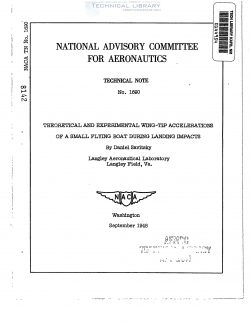naca-tn-1690
- Version
- 131 Downloads
- 1.50 MB File Size
- 1 File Count
- December 6, 2016 Create Date
- December 6, 2016 Last Updated
National Advisory Committee for Aeronautics, Technical Notes - Theoretical and Experimental Wing Tip Accelerations of a Small Flying Boat During Landing Impacts

A simplified analytical method for predicting the time history of
the accelerations along the wing of an airplane during landing impact
is presented and compared with wing—tip—acceleration data obtained from
full—scale landing tests of a small seaplane. The structural properties
of the seaplane were such that only the fundamental wing bending mode
of vibration had an important effect on the wing—tip accelerations and
the over-all structural properties had little effect on the hydrodynamic
impact force. For these conditions, the theoretical and experimental
time histories of wing-tip acceleration show very good agreement.
A sine curve is used as an approximation for the force—time
variation of the measured impact force and agrees fairly closely
with the experimental impact—force time histories up to and somewhat
beyond the time of maximum impact load.
Where the most severe impacts of the" tested seaplane occurred
subsequent to the initial impact of a particular landing, the seaplane
bounce that preceded this severe impact was usually sufficiently high
and of long enough duration to stop the wing vibrations excited by
the prior impact.
The construction of large flexible airplanes has increased the
importance of evaluating the effects of airframe elasticity in producing
critical design loads in the structure during landing impact. In order
to enable the designer to calculate these dynamic inertia loads without
having to employ the lengthy and tedious calculations required for an
exact solution of the problem, various theoretical methods for a
relatively simple and quick solution of the structural elasticity
problems have been developed. Several of these solutions are described
in references 1 and 2. Although each of these simplified methods is
based on advanced vibration theory, the resultant final solutions
presented in each have certain limitations so that they are not generally
applicable to all phases of the structural response problem.
| File | Action |
|---|---|
| naca-tn-1690 Theoretical and Experimental Wing Tip Accelerations of a Small Flying Boat During Landing Impacts.pdf | Download |

Comment On This Post